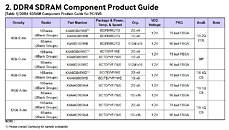Sunday, May 5th 2019

Samsung Kills Production of Famed B-die DDR4 Memory in Favor or Higher Densities
As the world becomes more and more centered on data, as well as its processing and storage, increased memory density across products is becoming more of a necessity. It seems that out of this necessity and a need to streamline its memory production towards favoring denser outputs, Samsung is killing of the famous B-die chips, which were - and still are - part of a love affair with any enthusiast's Ryzen desktop.
Memory compatibility issues with the first gen Ryzen took a while to dissipate, and didn't vanish entirely; however, overclockers quickly found that the most stable and overclockable memory ICs all were of the Samsung B-die type. Now, the company has updated its product catalogue to reflect EOL (End of Life) status for B-dies, replacing it with denser M-Die and A-Die products. M-dies were supposed to bring 32 GB densities to a single rank of memory - and have apparently been siphoned off to server applications and left out in the cold for consumer purchase), while the new A dies increase memory density per IC, meaning less of these are necessary to achieve the same final memory footprint. Whether or not these will feature the same Ryzen compatibility and overclockability as their B-die predecessors is unknown at this point, but it would make a lot of enthusiasts slightly unhappy - and increase the value of B-die offerings in any sort of discerning second-hand market - if they did not.
Sources:
Tom's Hardware, Samsung Product Catalog
Memory compatibility issues with the first gen Ryzen took a while to dissipate, and didn't vanish entirely; however, overclockers quickly found that the most stable and overclockable memory ICs all were of the Samsung B-die type. Now, the company has updated its product catalogue to reflect EOL (End of Life) status for B-dies, replacing it with denser M-Die and A-Die products. M-dies were supposed to bring 32 GB densities to a single rank of memory - and have apparently been siphoned off to server applications and left out in the cold for consumer purchase), while the new A dies increase memory density per IC, meaning less of these are necessary to achieve the same final memory footprint. Whether or not these will feature the same Ryzen compatibility and overclockability as their B-die predecessors is unknown at this point, but it would make a lot of enthusiasts slightly unhappy - and increase the value of B-die offerings in any sort of discerning second-hand market - if they did not.

30 Comments on Samsung Kills Production of Famed B-die DDR4 Memory in Favor or Higher Densities
www.samsung.com/semiconductor/dram/ddr4/
Shown below are the most relevant 1G x 8 configurations.
Seemingly the most prevalent B-die is part number K4A8G085WB-BCPB which happens to be the "worst" 8Gb (1GB x 8 - single-rank) B-die rated at just DDR4-2133 CL15, simply JEDEC spec. Even the "better" stuff was rated for just DDR4-2666 CL19 - not exactly breaking records. Have a look at the datasheet. It's companies like G.Skill and Corsair that screen the ICs, manufacture the PCB, and sell memory kits with SPD profiles that increase the speed and tighten the timings beyond JEDEC spec.
The assumption is that the new 10 nm B-die will scale as well, if not better, with voltage as the 20 nm B-die, which means we may see higher speeds and tighter timings when overclocking. I'm wondering if some of the 10 nm ICs have already hit the market in memory kits such as both G.Skill's and Corsair's DDR4-4800 CL18 memory kits, with ultra low calculated latency of just 7.5 nanoseconds at 1.5V, making it the fastest that I know of.
It was a huge difference but more and more kits come around now that so well
I have some hynix 16gb dimms at 3466 cl15..
3200 cl16 rated g. Skill sniperx
Ofc someone will say that "you don´t notice any difference past <insert Ram speed here>". Wich is wrong as we know.
Matching cl14 b-die sticks & timings later could become a nightmare once the supply channel dries up.
A bit like nand memory; SLC, MLC, TLC, QLC. For the average user QLC is now probably good enough, but there are other good reasons to use the more expensive and robust types of nand.